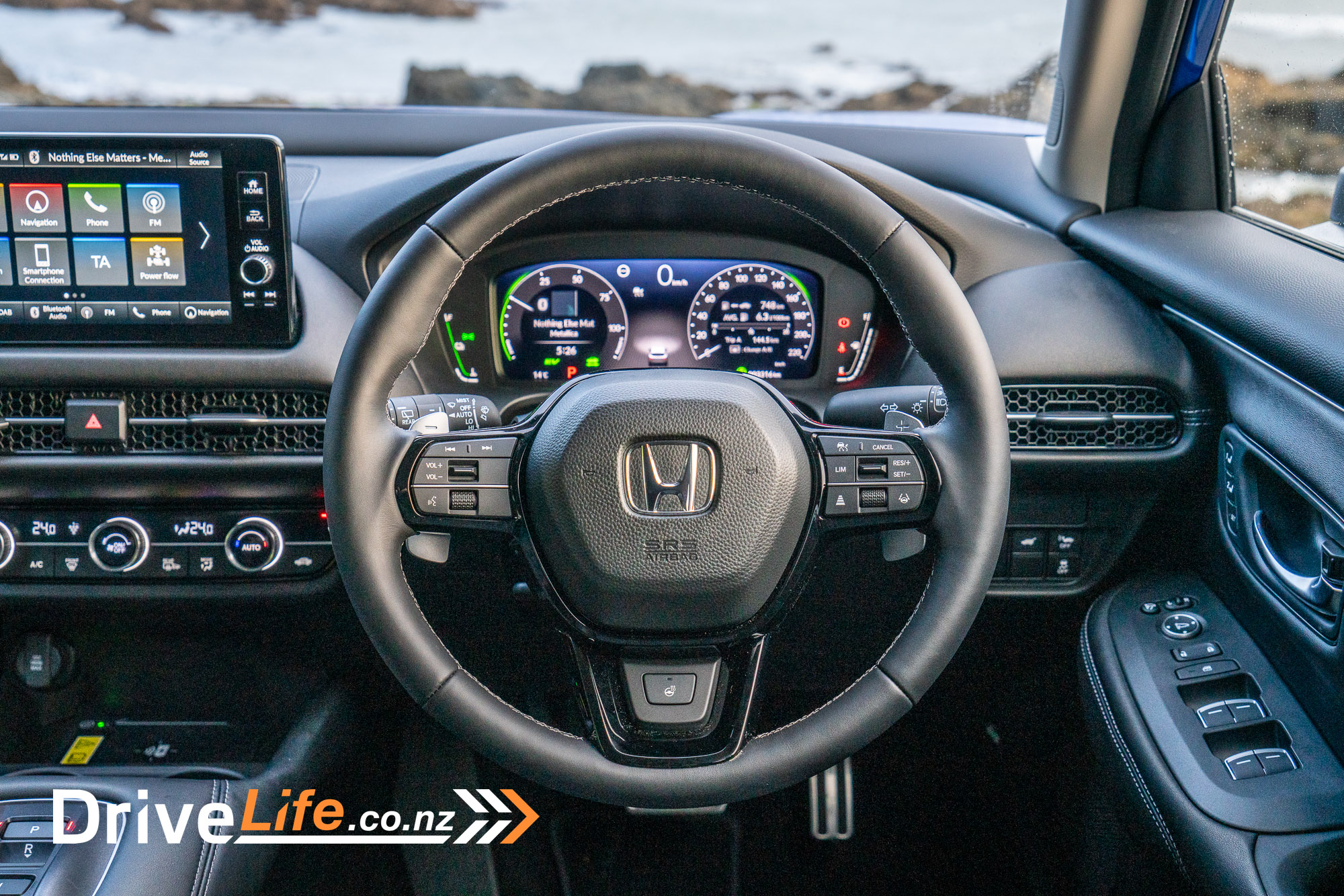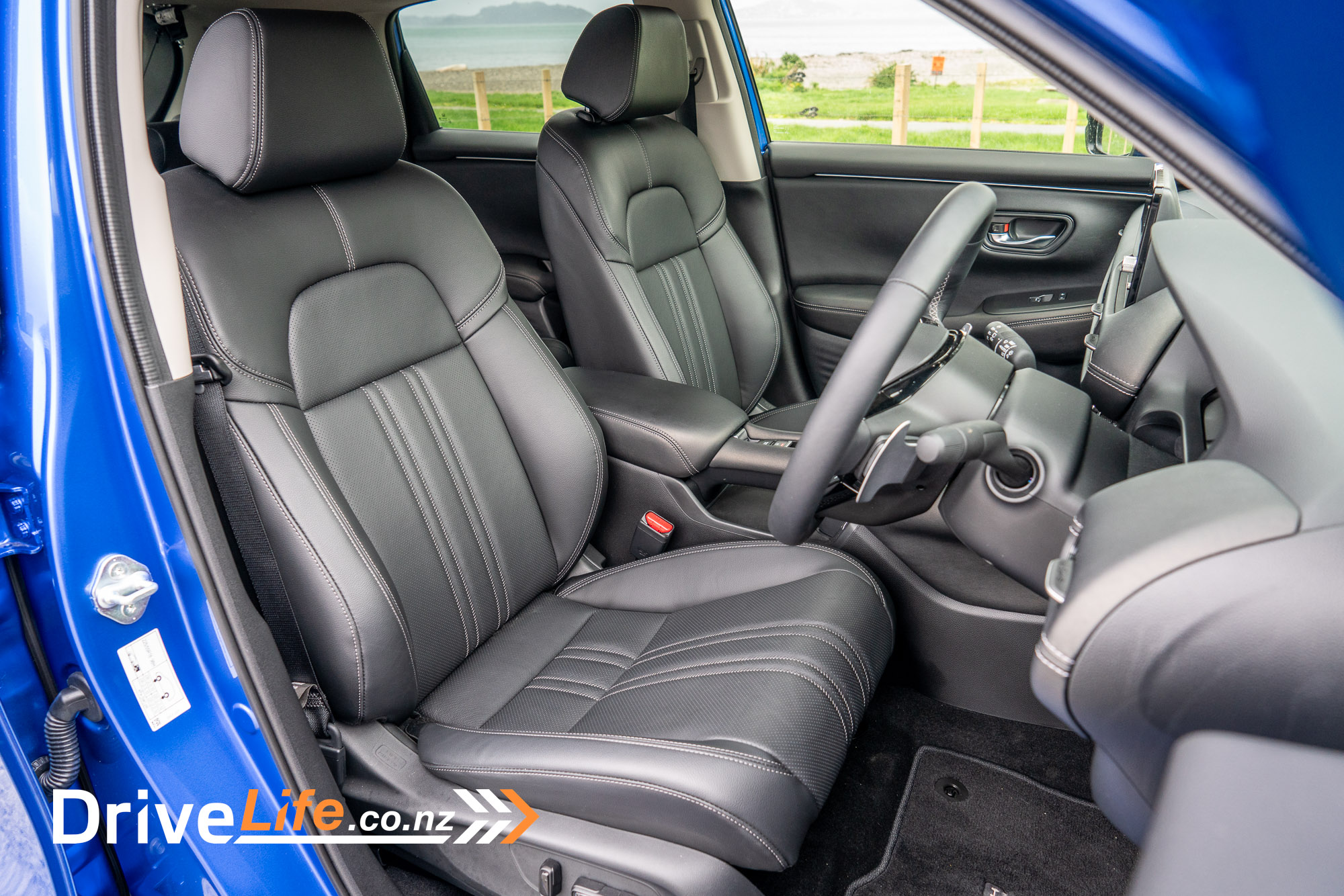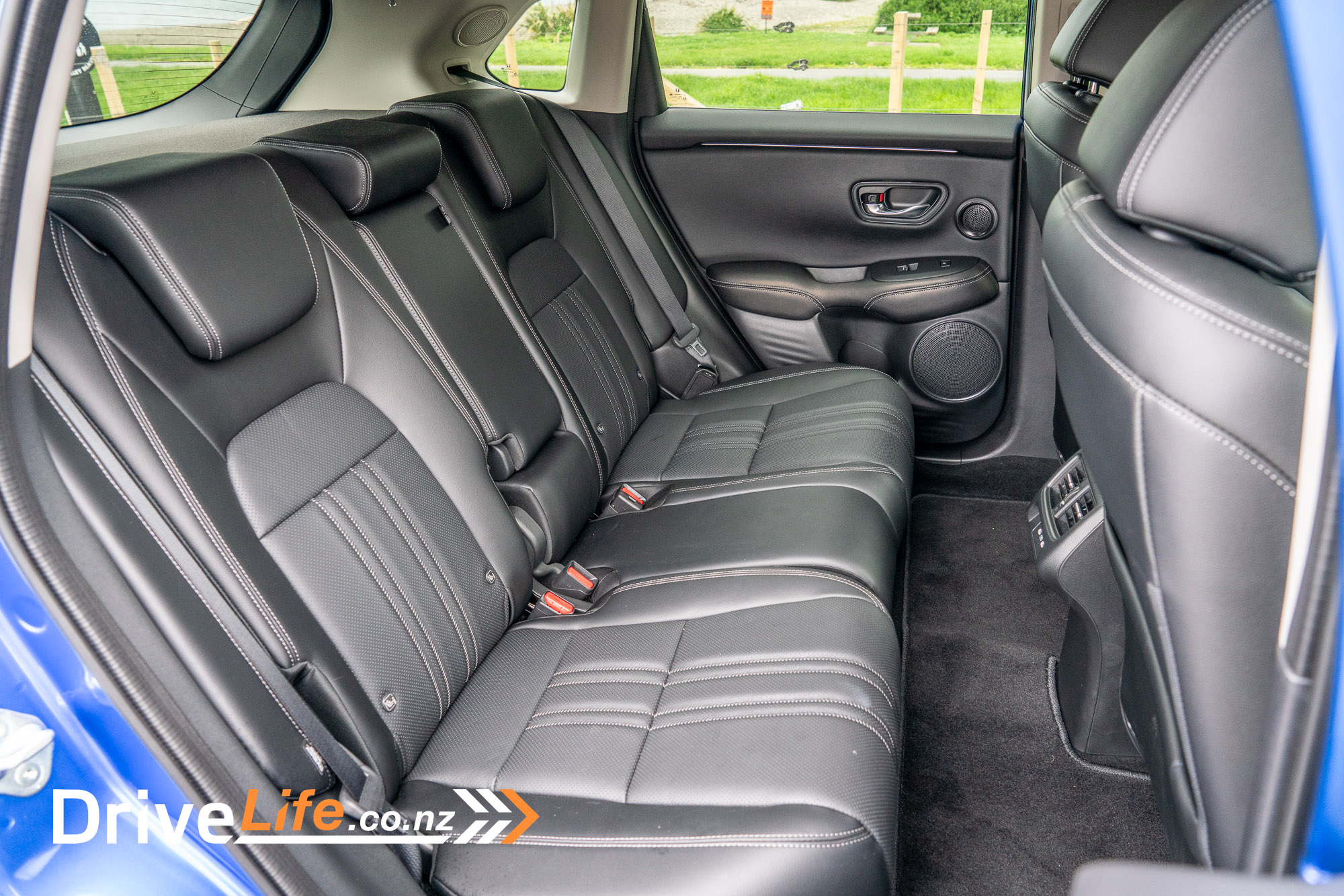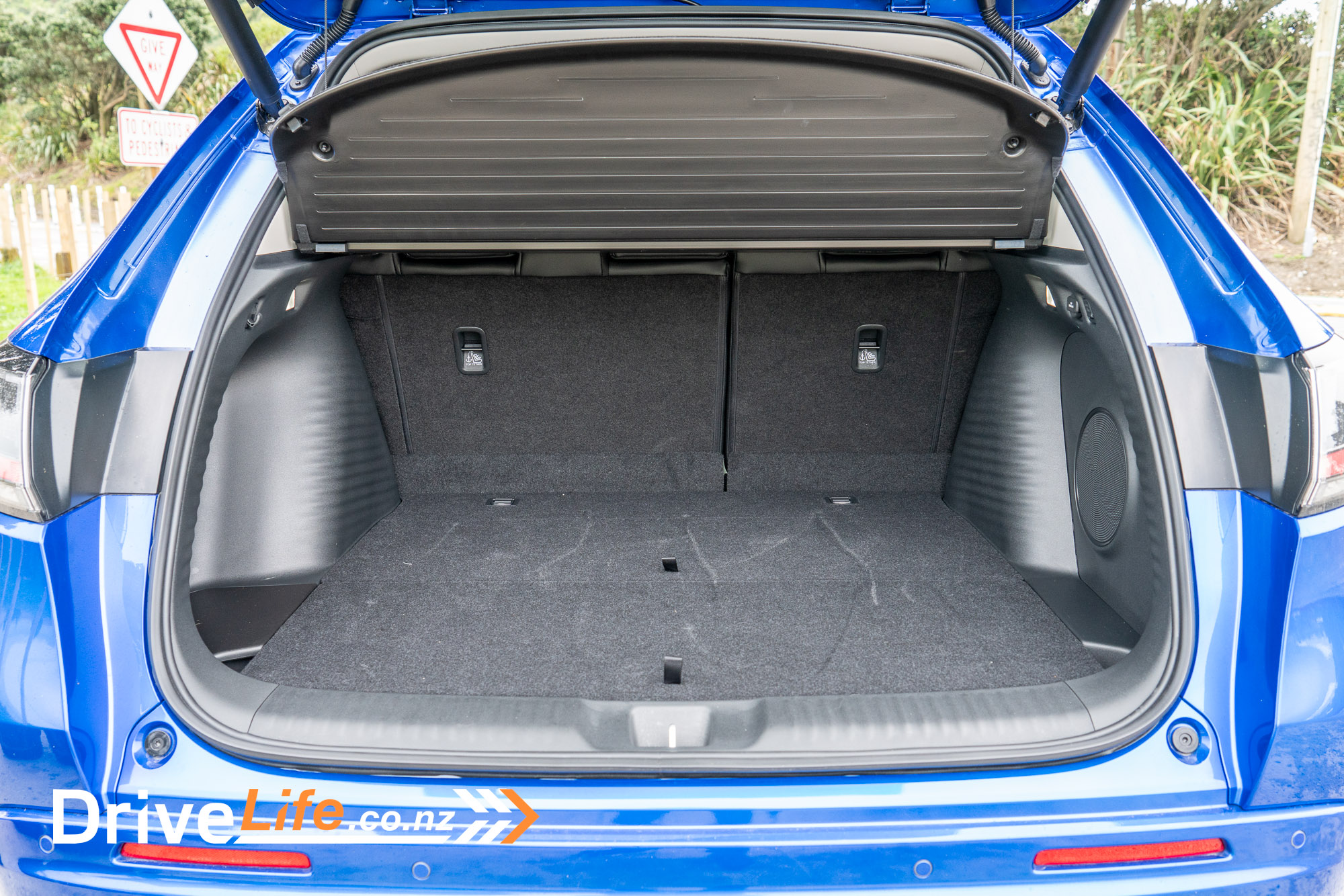For a company which produces more engines than anyone else in the world, Honda offers only a small range of vehicles in New Zealand.
Essentially, there have been five models holding the fort for years. The Jazz, the Civic, the HR-V, the CR-V and the Civic Type R. Each car is a commercial success in its own right, and most, I’d say are names which are household recognisable.
So, if you were to add to the range, and with a market clamouring for small SUVs in 2023… yeah, you see where this is going, don’t you?
The Honda ZR-V is the brand’s newest small crossover SUV. Sharing the majority of its bones with the Honda Civic, the ZR-V marks Honda’s push towards more premium vehicle offerings, all the while promising to keep driver engagement at the forefront of the experience. Tall orders for a newcomer, for sure.
So, is the new ZR-V all that it’s cracked up to be?

What We Like and Dislike About The 2023 Honda ZR-V Sport
| What we like | What we don’t like |
| Clever hybrid drive-train Interior design Build quality Decent handling Good tech | Ride quality only average No magic seats Not much else… |

What’s In the 2023 Honda ZR-V Range?
I bet some of you are wondering whether the ZR-V is a replacement for the HR-V. The answer is no, it’s not. Although, I wouldn’t blame you for being confused.
The HR-V is a similar, but a different SUV to the ZR-V. Both are currently available in Japan, the UK, and Europe. That said, in the USA, this ZR-V is sold as the HR-V.
Yeah, I’m not sure how it works either.
Anyway, there are two different Honda ZR-V models available for Kiwi buyers; the ZR-V Turbo is the entry-level model, and the ZR-V Sport is the top-spec model.
| Model | Engine | Type | Price |
| Honda ZR-V Turbo | 1.5-litre turbocharged 4-cylinder petrol | Petrol | $47,000 |
| Honda ZR-V Sport | 2.0-litre hybrid 4-cylinder petrol | Hybrid | $55,000 |

2023 Honda ZR-V Standard Equipment Highlights
The entry-level ZR-V Turbo offers:
- 10.2″ Drivers Display
- 18″ Alloy Wheels
- 6-speaker audio system
- 9″ infotainment with Apple CarPlay, Android Auto and Bluetooth
- Ambient interior lighting
- Auto-Dimming Rear View Mirror
- Auto lights
- Auto wipers
- Dual Zone Digital Climate Control
- Front and rear parking sensors
- Heated Front Seats
- Heated mirrors
- Honda Connect App
- Leather and Fabric upholstery
- LED daytime running lights
- LED headlights
- LED sequential indicators
- LED taillights
- Manually Adjustable Driver’s Seat
- Power Tailgate
- Push Button Start/Stop
- Rear Privacy Glass
- Reversing Camera
- Smart Proximity Key
- ‘Walk Away’ Door Locking
The top-spec ZR-V Sport adds:
- 12-speaker Bose audio system
- 360-degree Camera
- 8-way Power Adjustable Driver’s Seat with Memory
- 4-way Power Adjust Front Seat
- Alloy Sports Pedals
- Auto Tilt Mirrors (Reverse)
- Heated Rear Seats
- Heated Steering Wheel
- In-built Sat-Nav
- Leather seat upholstery
- Polished Alloys
- Wireless charging
Both ZR-V models feature “Honda Sensing Technology” and Active Safety. In other words, these safety features come standard:
- 7-airbags
- Adaptive Cruise Control (ACC)
- Agile Handling Assist (AHA)
- Collision Mitigation Braking System (CMBS)
- Driver Attention Monitor
- Emergency Brake Assist (EBA)
- Forward Collision Warning (FCW)
- Hill Start Assist (HSA)
- ISO-FIX
- Lane Departure Warning (LDW)
- Lane Keep Assist System (LKAS)
- Road Departure Mitigation (RDM)
- Speed Recognition Function
- Traction Control (TCS)
- Traffic Jam Assist (TJA)
- Tyre Deflation Warning System (DWS)
- Vehicle Stability Assist (VSA)
The ZR-V Sport adds:
- Blind Spot Monitoring
There are 6 colours to choose from for your ZR-V:
- Nordic Forest Pearl (Blue Grey)
- Premium Crystal Garnet Metallic (Burgundy Red)
- Platinum Gray Metallic
- Platinum White Pearl
- Crystal Black Pearl
- Premium Crystal Blue
For more information on the Honda ZR-V, check out the Honda New Zealand website.


How Does The 2023 Honda ZR-V Sport Compare To Its Competition?
The world is your oyster when it comes to small-to-mid-size crossovers. Although, the options reduce if you’re set on a hybrid. Here are some of your options.
| Make/ Model | Engine | Power/Torque (kW/Nm) | Seats | Fuel (L/100km) | Towing capacity | Boot space (litres) | Price (excl CCP) |
| Hyundai Kona Active N-Line Hybrid | 1.6-litre 4-cylinder hybrid | 104/265 | 5 | 4.3 | 600/1300 | 407 | $65,990 |
| Kia Niro HEV GT-Line | 1.6-litre 4-cylinder hybrid | 104/265 | 5 | 4.4 | 600/1300 | 451 | $59,990 |
| Nissan Qashqai Ti-L e-Power | 1.5-litre 3-cylinder hybrid | 140/330 | 5 | 5.8 | 750/750 | 452 | $60,990 |
| Mitsubishi Eclipse Cross PHEV VRX | 2.5-litre 4-cylinder hybrid | 94/199 | 5 | 2.1 | 750/1500 | 359 | $59,990 |
| Honda ZR-V Sport | 2.0-litre 4-cylinder hybrid | 135/315 | 5 | 5.5 | 700/750 | 370 | $55,000 |
| Toyota Corolla Cross Limited Hybrid | 2.0-litre 4-cylinder hybrid | 112/190 | 5 | 4.9 | 750/750 | – | $53,190 |
| Haval Jolion Hybrid | 1.5-litre 4-cylinder hybrid | 139/375 | 5 | 5.0 | 710/1500 | 390 | $39,990 |

First Impressions Of The 2023 Honda ZR-V Sport
This Honda ZR-V is blue. Very blue.
Perhaps even the bluest blue to have ever blued. Someone even said to me it was the bluest car they’d ever seen (I’m not joking). That’s because this blue paintwork has a real depth to it, which signals a sense of quality about the ZR-V.
Underneath the paint job is an inoffensive design. I wouldn’t say the ZR-V is a looker, but it’s not ugly by any stretch. The front grille does look slightly awkward to my eye, but generally, the ZR-V design is pleasant enough to not deter anybody from buying one.

What’s The Interior Like In The 2023 Honda ZR-V Sport?
If you looked at the interior of the Honda Civic and thought, “I’d like this, but slightly bigger”. That’s essentially the cabin of the ZR-V. At least, that’d be the view from the front seats, anyway.

Like many automakers, Honda has begun to standardise significant parts of their interiors. The Civic, the ZR-V and the new CR-V all look more-or-less similar from the front seats. The dashboard design is the same, the climate control stack is the same, same infotainment, same steering wheel, instrument cluster – you get the idea.
Sure, there is something to be said about a loss of character between each model by following this approach. But, there are a few advantages which aren’t directly related to the firm’s bottom line.

One of those advantages is design optimisation. Basically, Honda can pour their collective resources into the development of one modular design and then make that money go as far as possible. In theory, that should make parts cheaper too, if something breaks (not likely in a Honda, I know).
Anyway, car companies have been doing this stuff for years, but lesser so with interiors. Importantly, has this standardised approach worked for them? In a nutshell, yes. It has.

In my view, this is one of the most well-thought-out interiors you’ll find in this segment. It’s a modern design, which does well by balancing technology with legacy physical controls. The textures and the build quality are also excellent. Seriously, the fit-and-finish in here could easily embarrass some more expensive European metal.
I will concede, however, that Honda’s design doesn’t exactly have the same sort of wow factor that one might get from, say, a modern Mazda. Instead, this interior is the sort you’ll appreciate more as you live with it.

That’s from the front, anyway. Of course, it’s not entirely same-same for each Honda. The ZR-V’s cabin is unique with its rounded elements, and this is particularly noticeable on the doors and the centre console. The gear selector is a novel design too, being a series of buttons as opposed to a traditional shifter.
As specs go, the ZR-V Sport is top of the rung, meaning it gets all the trimmings as standard. On the tech front, the ZR-V Sport gets a 12.3’’ digital dash cluster (which isn’t available in the Civic), Honda’s latest infotainment unit which is paired with a 12-speaker Bose audio system.

The infotainment has good resolution and decent responsiveness and the tile-based UI is simple to interact with while driving. The Bose audio system is among the better systems in this segment – it’s a solid mid-range system.
The digital instrument cluster is a nice bit of kit compared with the half cluster in the Civic. It has good graphics, resolution, and a small amount of configurability.
Another area where Honda typically excels is in interior space and layout. The ZR-V’s driving position is in a Goldilocks zone – it’s neither too high nor too low. The front seats are comfortable and have wide bolstering. In the Civic Sport, I did find the seats could have benefited from more lumbar support. Although the ZR-V’s 8-way powered drivers seat, which includes adjustable lumbar, more than compensated for the Civic’s shortcoming.

On the matter of space, there’s plenty for the front occupants and an ample amount for the rear. Adults will not be punished in the back seats, that’s for sure. The boot space is 370L, expanding up to a sizable 1,302L with the rear seats down.
There is one downside, however. The new ‘HA’ platform Honda utilises to build the new Civic, ZR-V and CR-V upon can no longer accommodate Honda’s patented ‘magic’ seats. Sadly, the only car in Honda’s range to still have magic seats is the Jazz. Tis a shame, really.

Although, the ZR-V does redeem itself in other ways, particularly on the tech front. The ZR-V debuts with Honda’s newly developed Honda Connect App, which allows you to remotely switch on the lights, lock the doors, adjust the climate control, and geo-locate the car among other features.
Honda has also developed some common-sense technology for their new vehicles. In particular, the ZR-V has a feature called ‘walk away locking’, where you can lock the car while other passengers’ doors are still open. Basically, if your kids are taking their time to close their doors, you can still lock the car and walk away. The open door will lock once it is closed. Clever stuff.

What’s The 2023 Honda ZR-V Sport Like To Drive?
The term “Hybrid” has become somewhat of a catch-all term in the automotive world. To the layman, a hybrid is a car that’s part electric, part petrol. It’s not far off, for the most part.

Although, like many things in this world, there’s a lot more complexity behind this definition. If you look further into the automotive glossary, you’ll find there are three main types of Hybrid vehicles, being Mild Hybrids, Full Hybrids and Plug-in Hybrids.
Then, there are different approaches to building a hybrid drivetrain, of which there are series hybrids, parallel hybrids and series-parallel hybrids. Every manufacturer has their own approach too, especially when optimising their own combustion engines to work alongside the hybrid bits.
You can really go down the rabbit hole if you’ve got a few spare evenings. So, what has Honda done with the ZR-V Sport?
The ZR-V Sport is powered by Honda’s 2.0-litre e:HEV 4-cylinder hybrid engine coupled with Honda’s “e-CVT” transmission, producing a combined output of 135kW of power and 315Nm of torque. Honda’s approach to hybrid powertrains is quite unique, which does require a bit of explaining. To avoid going down the previously mentioned rabbit hole, I’ll give you a short and a long version.

In short, the Honda ZR-V Sport is a series-parallel full hybrid vehicle. Cool.
It’s either solely driven by its electric motor or by its petrol engine. Okay.
It means it’s fuel efficient. Great!
About 5.5L per 100kms, Honda will tell you. Excellent.
We got around 6.0L per 100kms. Oh, okay.
Now, how about the longer version?

The e:HEV powertrain utilises a traditional combustion engine, a generator, two electric motors, and a battery. Being a series-parallel hybrid, the electric motors perform most of the driving, while the petrol engine works to power a generator which charges the battery. When up to higher speeds (and occasionally at low speeds), a clutch engages which switches the driving to the petrol engine.
The gearbox is even cleverer. Honda calls it the “e-CVT”, but it’s not really a CVT in the conventional sense. Instead, it’s a combination of the electric motors and a series of clutches in charge of the power flows, meaning this ‘e-CVT’ is more like a direct-drive unit as opposed to a belt-driven CVT. That said, Honda programmed in a ‘step shift’ to make it feel more like a conventional gearbox. Confused? Yeah, I don’t blame you.
Because it is predominantly electric motor-driven, the ZR-V’s performance delivery is, well, a bit EV-like. Overall, it’s exceptionally smooth and even the switch between the electric motors and the petrol engine at higher speed is nearly seamless, you’d not even notice.
However, this powertrain can feel a bit synthetic from behind the wheel. You can hear an engine running, and a gearbox that’s ‘shifting’ (or pretending to), but the power is being delivered in an EV-like manner.
It’s a bit of an odd experience when you first start driving, I’ll admit, but you do adjust to it.

With all this electrical-mechanical engineering complexity, you’d probably expect the ZR-V Sport to weigh as much as a bus. Surprisingly, Honda has managed to keep the weight under control, with the ZR-V Sport tipping the scales at 1,586kg – only 100kg more than the petrol-only ZR-V Turbo.
Between this and 315Nm of torque, the ZR-V Sport does more than just meander. Off-the-line and through the mid-range, the ZR-V provides healthy performance. Given that it’s only 135kW, the ZR-V does run out of breath towards the top end, but that’s to be expected amongst nearly all crossovers in this segment.
Handling is another strength. The chassis is nicely balanced for a crossover, and it has tidy body control. The steering also weighs up nicely, providing the driver with a bit of confidence in their inputs.
It all means the ZR-V Sport takes to the twisty stuff rather well. That said, I wouldn’t call it an exciting experience. Instead, it’s better described as a confident, yet safe feeling. All said, its handling is great amongst its crossover peers.

Okay, but what about round town? Well, it’s not exactly Honda Jazz, and I reckon the turning circle could be better, but it’s nothing too dissimilar to other mid-size crossovers. It’s the same story for the ride quality as well, being neither the best nor the worst amongst its peers.
The situation improves again with safety technology. The ZR-V comes equipped with ‘Honda Sensing’, which is Honda’s catch-all term for their suite of driver and safety assistance software. Importantly, the ZR-V’s safety technology is well-calibrated. The Adaptive Cruise Control has smooth inputs, and the Lane Keep Assist assistance is one of the more precise systems among competitors. The only irritating bit is the Road Departure Mitigation, which can be overbearing on tighter roads. Fortunately, it’s easy enough to switch it off.

2023 Honda ZR-V Sport – Specifications
| Vehicle Type | 4-door small crossover |
| Starting Price | $55,000 |
| Price as Tested | $55,000 |
| Engine | 2.0-litre e:HEV 4-cylinder petrol hybrid |
| Power, Torque, kW/Nm | 135/315 |
| Transmission | e-CVT |
| Spare Wheel | Repair kit |
| Kerb Weight, Kg | 1,586 |
| Length x Width x Height, mm | 4568 x 1840 x 1620 |
| Cargo Capacity, Litres | 370/1302 |
| Fuel tank capacity, litres | 57 (91 or higher) |
| Fuel Economy, L/100km | Advertised Spec – Combined – 5.5 Real-World Test – Combined – 6.0 Low Usage: 0-6 / Medium Usage 6-12 / High Usage 12+ |
| Towing Capacity Kg, unbraked/braked | 700/750 |
| Turning circle, metres | 11.0 Small: 6-10m / Medium 10-12m / Large 12m+ |
| Warranty | 5-year/unlimited-km manufacturer’s warranty 5-year roadside assist 5-year battery warranty, 100,000km |
| Safety information | ANCAP Rating – 5 stars – Not assessed. Rightcar.govt.nz – 5 Stars – PUR905 |
Have you enjoyed this review? Be sure to join our monthly email newsletter list so you don’t miss a single review!






















